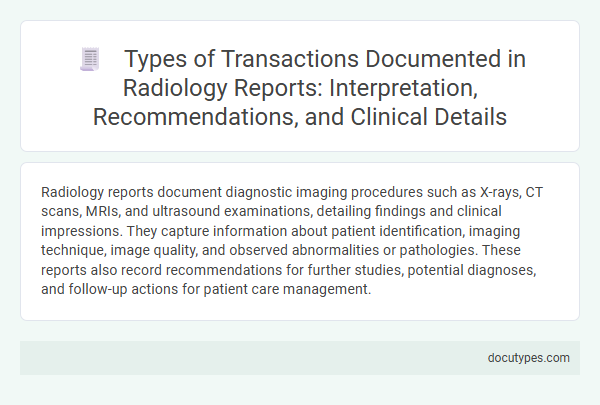Radiology reports document diagnostic imaging procedures such as X-rays, CT scans, MRIs, and ultrasound examinations, detailing findings and clinical impressions. They capture information about patient identification, imaging technique, image quality, and observed abnormalities or pathologies. These reports also record recommendations for further studies, potential diagnoses, and follow-up actions for patient care management.
Introduction to Radiology Report Transactions
A radiology report documents critical information from imaging studies performed during patient care. It records various transactions that detail findings, procedures, and interpretations essential for medical diagnosis.
- Imaging Examination Details - This section records the type of imaging study performed, including modality and anatomical focus.
- Findings and Observations - Radiologists document specific abnormalities or normal results detected during the examination.
- Diagnostic Impressions and Recommendations - The report summarizes conclusions and suggests further tests or treatments based on imaging results.
Key Components of Radiology Documentation
Radiology reports document critical transactions related to medical imaging procedures, including patient identification, examination type, and imaging technique used. These transactions ensure accurate communication between radiologists and referring physicians.
Key components of radiology documentation include clinical history, findings, impressions, and recommendations based on imaging results. Precise recording of each element supports effective diagnosis and treatment planning.
Interpretive Findings in Radiology Reports
Radiology reports document various types of transactions related to medical imaging studies, focusing primarily on the interpretive findings. These findings provide critical insights that guide diagnosis and treatment decisions.
- Identification of Abnormalities - The report highlights any detected abnormalities, such as tumors, fractures, or infections, based on the imaging results.
- Comparison with Previous Studies - Radiologists compare current images with prior exams to track changes or progression of a condition.
- Diagnostic Impressions - The report offers a professional interpretation suggesting possible diagnoses supported by the imaging evidence.
Interpretive findings in radiology reports are essential for accurate clinical decision-making and patient management.
Recommendations and Follow-Up Actions
Radiology reports document critical transactions involving diagnostic findings and clinical assessments. Recommendations and follow-up actions highlight necessary steps for patient management based on imaging results.
Recommendations often include specific imaging follow-ups, specialist consultations, or additional diagnostic tests to clarify uncertain findings. Follow-up actions ensure continuous patient monitoring and timely interventions, improving clinical outcomes. Clear documentation of these transactions facilitates coordinated care among healthcare providers.
Patient Demographics and Clinical Context
Radiology reports document various types of transactions, primarily focusing on patient demographics and clinical context. Patient demographics include essential details such as age, gender, and identification numbers, which ensure accurate record matching and personalized care.
Your clinical context involves the reason for imaging, symptoms presented, and relevant medical history. This information guides radiologists in interpreting images accurately and supports effective diagnosis and treatment planning.
Procedure and Technique Documentation
What types of transactions are recorded in a radiology report, specifically regarding procedure and technique documentation? Radiology reports detail the exact procedures performed, including imaging methods and equipment used. This documentation ensures Your healthcare providers have precise information about the diagnostic process for accurate interpretation and follow-up care.
Imaging Results and Observational Details
Radiology reports document critical medical transactions by recording detailed imaging results and observational details. These reports provide essential information that supports diagnosis and treatment planning.
- Imaging Results - High-resolution images from X-rays, MRIs, CT scans, or ultrasounds are analyzed and recorded to reveal anatomical structures and abnormalities.
- Descriptive Observations - Radiologists note specific findings such as lesion size, shape, location, and density to interpret the images accurately.
- Comparative Analysis - Previous imaging data may be compared with current results to track progression or changes in medical conditions.
Communication of Critical Results
| Transaction Type | Description | Importance in Radiology Report |
|---|---|---|
| Imaging Procedure Details | Documentation of the type of imaging performed (e.g., X-ray, MRI, CT scan), including technique and settings. | Ensures clarity about the diagnostic method used and aids in interpreting findings accurately. |
| Findings | Recorded observations of abnormalities or normal structures identified during the imaging study. | Forms the basis for diagnosis and clinical decision-making. |
| Interpretation | Analysis and clinical correlation of imaging findings by the radiologist. | Provides insight to guide your treatment plan or further investigations. |
| Communication of Critical Results | Timely notification of urgent or life-threatening findings directly to the referring physician or medical team. | Reduces the risk of delayed treatment and improves patient safety by ensuring prompt clinical response. |
| Recommendations | Suggestions for additional imaging, follow-up exams, or referral to specialists based on the results. | Supports comprehensive patient care and monitoring. |
| Patient and Study Identification | Records such as patient name, identification number, date of study, and imaging site. | Ensures accurate matching of report to the correct patient and exam. |
Documentation of Incidental Findings
Radiology reports document various types of transactions, including diagnostic imaging results, procedural details, and clinical impressions. Documentation of incidental findings is crucial, as it highlights unexpected abnormalities detected during imaging unrelated to the primary reason for the exam. Your healthcare provider relies on these records to ensure comprehensive patient care and appropriate follow-up for incidental discoveries.
What Types of Transactions Are Recorded in a Radiology Report? Infographic

